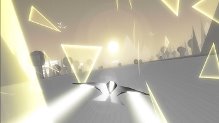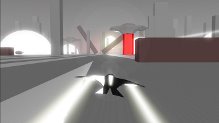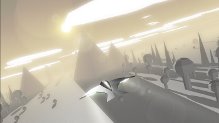Liverpool Sound and Vision Rating: 8.5 out of 10
Race the Sun is an endless runner racing game available for download from the PlayStation Store for the PS4, PS3 and PS Vita. The game was launched on the back of a successful Kickstarter campaign which saw 1,144 backers generously donate to Flippfly as the gaming community raised $1,579 more than their target of $20,000 required to develop and release the game across multiple platforms with the project receiving official status as being successfully funded on March 7th 2013.
Race the Sun sees the player piloting a solar craft as they steer towards the sunset, while attempting to avoid shadows and darkness cast by obstacles as they are the conditions that would weaken the ship by slowing it down; which is certainly not a positive situation to be in as your ship needs to be kept in sunlight in order to appropriately function.
There are four game modes including Race the Sun, Apocalypse, Labyrinthia and a playable credits scene. The Race the Sun mode is the original premise of the game, while Apocalypse is unlocked by reaching region 11 in the Race the Sun mode and ups the ante of just how fast players will have to engage their twitch reflexes and Labyrinthia is an exclusive game mode to the PlayStation versions of the game which is earned by successfully levelling up to level 25, although Labyrinthia actually does away with the concept of the Race the Sun mode; instead making way for a maze of ever changing obstacles, switches and paths that must be precisely navigated through. There are a range of power-ups to collect as players survive such as a blue shape that is called Tri which increases the points tally, a yellow shape which increases the length of time sunlight remains and a green shape that provides the ability for the ship to jump.
The Simplex World Creator has been removed in comparison to the original release of the game that features the effective creation tool which allows players to edit existing game modes or even create new game modes as well. The ability to create a world from afresh by layering it up individually piece by piece from a shape and movements of shapes to intricate background detail such as a flock of birds followed by sharing the creation with the world, tt is a shame that the Simplex World Creator has been omitted from the PlayStation versions as it would have taken the game in a user-created content direction that has only previously been ambitiously explored by games such as the Little Big Planet franchise. It has been stated that the creative feature may be brought to the game in the future, although only time will tell if that actually becomes a reality.
The craft design is customisable as there is a range of attachments that allows players to configure the ship, although players start out with the basic ship and a listing of various tasks to complete in order to unlock the attachments required to upgrade the ship such as equipping an attachment to it to attract pickups and Tris from a greater distance. The tasks include playing two rounds which is certainly the easiest task, while the rest tend to be harder such as travelling a distance of 15,000 in one round, clearing two regions without any collisions in one round, collecting a certain amount of tris and much more besides.
The environment design is abstract in design as it comprises of various shapes, while simultaneously being incredibly ambitious as the world is procedurally generated as it resets every 24 hours to make for a far more unpredictable experience with different arrangements and movements of shapes, therefore creating entirely unique paths to steer through everyday.
There is a sense of levelling up and XP tied into the core gameplay mechanics in the same circumstances as the customisable craft design as new knowledge is unlocked regarding score multipliers and collectables that have different powers such as extending the amount of time the sun remains in the sky, which is all brought about by completing tasks to gain a point towards the number of total required to level-up, with each occasion of levelling-up resulting in such rewards. This is a positive design choice as it is providing a lot of unlockable content as progression is made through the game, while giving an air of satisfaction as completion of each task is made as players know they are progressing towards a goal for new tasks to be played in an easily accessible fashion.
Race the Sun supports the share feature that allows players to upload a video clip or a screen shot to Facebook or Twitter; and broadcast live gameplay footage via Twitch or Ustream as it is being experienced with a simple tap of the share button and selecting the option of choice. The PS4’s hard-drive continuously stores the most recent fifteen minutes of gameplay footage, so players still have the chance to decide if they would like to share something amazing a few minutes after it has taken place. The share feature is a next-gen revolution that has only improved with the further customisation provided by the Share Factory app that allows commentary, music, themes, stickers, effects, text, picture-in-picture video between game footage and the player’s reaction from the PlayStation Camera and much more besides, which will only continue to prosper and flourish as it matures with additional features and further experimentation in the future. The Share Play feature provides a platform for a gamer that does not own the game to take control of the game started and invited that person to play, although it only lasts for one hour; it is a great service as it effectively presents a one hour demo of the game to anyone invited who does not own it, while being an excellent sociable feature too.
Race the Sun supports cross-buy and cross-save between the PS4, PS3 and Vita. Cross-buy presents a superb amount of value as it means that you will be purchasing the PS4, PS3 and Vita versions of the game with just a single purchase. The cross-save functionality allows players to sync the progression of the save file from the Vita to the PS3 or PS4 and vice versa, so the game can be started on the Vita on the way to and from work, sync the saved game when returned home and then resume where left off by loading the save game and continuing via the PS3 or PS4 version.
The controls are quite simplistic as the control scheme consists of changing the direction of the left analogue stick or alternatively pressing left or right on the d-pad to steer the craft; pressing X to jump; pressing the share button takes the player to the share feature menu; and pressing the options button to display the pause menu. There is no implementation for the touch pad, light bar and vibration which is surprising as the touch pad could have provided an alternative to the left analogue stick and d-pad to steering the ship by swiping across from left to right and vice versa in the appropriate direction, while the light bar could have flashed light blue when having collected a Tri, flashing yellow for collecting a sunlight power-up, flashing green for a jumping ability, sustained green during a jump, flashing red during a collision and sustained red after a crash, alongside vibration for colliding with an obstacle and heavier vibration for crashing the ship.
The graphics are presented in a quite simplistic yet abstract styling as various shapes such as triangles, squares and spheres make up the surroundings, while the actual performance of the game is of a high standard as it outputs at 1080P and 60 frames per second.
The presentation of the game is solid with a great user interface across various menus such as the main menu, ship configuration attachments, options and gameplay menus with support for navigation via the left analogue stick, directional pad and face buttons, although it does not include support for navigation via the right analogue stick and touch pad, while the background is simply black and a silver arrow pointing in the direction of another gameplay menu.
The audio consists of sound effects and music with the sound effects including sounds for when a tri or power-up is collected as well as during a jump and when there has been a partial collision or a full on crash with an object, while the music is an original eclectic fusion of Egyptian, dance and classical music. There is no DualShock 4 speaker implementation which is surprising as it could have produced the incidental sound effects such as collecting power-ups, jumping, colliding and crashing or perhaps even the music.
The trophy list includes 13 trophies with 9 bronze, 3 silver and 1 gold trophy. There are a couple of easier trophies that will be naturally earned as progression is made through the story such as the Sparrow bronze trophy for reaching level 3 and the Swallow bronze trophy for reaching level 10, although there are much harder trophies including the Eagle bronze trophy for reaching level 25; the Knight silver trophy for scoring 1 million points in a single run; the King gold trophy for scoring 5 million points in a single run; the Meteoroid silver trophy for clearing region 4 in Apocalypse; the Yeager silver trophy for finishing 6 perfect runs in a single run; and the Wright bronze trophy for collecting 50 tris in-air in a single run. It is estimated that depending upon skill and a good trophy guide to provide some helpful tips that it would take between 10 to 15 hours to 100% the trophy list.
There are no difficulty levels, although the difficulty curve is quite high as players will not necessarily find it easy to become accustomed to the pace of the ship, especially when there are so many obstacles that are rapidly gaining ground on, although earning new power-ups and customising the craft with new attachments will certainly help point the player in the appropriate direction.
The PlayStation versions have had the co-operative multiplayer removed that was originally planned to be included which is surprising as it could have had a split-screen race to see who would cross the finishing line of a set length or period of time first or for a multiplayer component to have at least consisted of pass the controller multiplayer to see who could complete each region the fastest, who could average the fastest speed over a set amount of regions and who could collect the most tris in each region.
However, there are online leaderboards that are shared between the three versions of the game as they focus on worldwide rankings and friends rankings daily for the last week and all time with each leaderboard containing each player’s rank; name (PSN ID); and their total amount of points accumulated with the positioning of each player based upon their total points, which totals to 16 leaderboards.
Despite the omissions of co-operative multiplayer and the Simplex World Creator from the PlayStation versions; there is still a lot of replayability such as levelling up by completing a variety of tasks to unlock many new gameplay elements, ship customization and most importantly a daily procedurally generated world to keep the gameplay unpredictable.
Overall, Race the Sun is a perfect blend of an endless runner and a racing game that works in perfect harmony to create a world in which one mistake can risk the very survival of the ship’s existence and send the player right back to the start. If you are a fan of the endless runner or racing genres and are looking for a challenging game with unique gameplay mechanics, then Race the Sun is certainly that game, especially given such exceptional value at £7.39* for a triple cross-buy purchase.
Jason Bonnar
Analysis
- Title: Race the Sun
- Developer: Flippfly
- Publisher: Flippfly
- System: PS4, PS3 and PS Vita
- Format: PSN Download
- Cross-Buy: Yes (PS4, PS3 and PS Vita)
- Cross-Play: Yes (Cross-Save)
- Players: 1 (Online Leaderboards)
- Hard Drive Space Required: 290MB (Version 1.01)
- * Correct at time of going to press, 14/01/2015.


